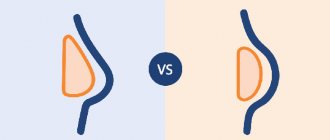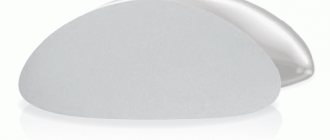Characteristics of breast implants
Breast implants differ in more than just their shape. They have many characteristics, and the choice of each of them depends on many components. Let's look at the main ones.
Form
The shape of the endoprosthesis determines how natural the breasts will look after plastic surgery. There are two forms of implants:
- round (hemispherical) - the highest point is located in the center of the implant;
- anatomical - they have a teardrop shape, as close as possible to the natural female breast.
Size
Sometimes patients mistakenly believe that only volume affects the size of the implant, but this is not true. Breasts with implants of the same volume will look different on patients with wide and narrow chests. Therefore, the size is determined by three parameters of the endoprosthesis:
- volume - measured in milliliters or grams;
- projection - its height from the base to the top of the dome;
- profile - the relationship between the projection and the width of the base.
Profile
The profile is the ratio of the projection of the implant to the width of its base. It is divided into four categories:
- Low (mini).
This implant has a wide base and a small projection. Low-profile implant models are rarely installed in women undergoing augmentation mammoplasty. They often perform minor corrections for ptosis. - Medium (demi).
This implant profile is chosen when they want to ensure that the breast after mammoplasty looks as natural as possible. Sometimes it is installed as a temporary option in order to then switch to a high profile. - High (full).
The most popular option among those who want beautiful and high breasts. This option is suitable for women with a narrow chest, as well as significant prolapse of the mammary glands. - Extra high (corse).
The highest profile is unnaturally large in size. It is chosen by those who like to attract attention, for example, artists and show business divas.
How much the breasts will stand out after correction depends on the profile.
Surface type
The first breast implants were smooth. The advantages of smooth models include softness, but they often change position inside the implant pocket. Capsular contracture often forms around them, that is, excessive proliferation of fibrous tissue.
Smooth ones were replaced by endoprostheses with a textured or rough surface. The embossed surface of the implant provides better adhesion to the tissues in the encapsular pocket, so such an endoprosthesis moves much less frequently. The fibrous membrane grows less around it. The only drawback of such an implant, which develops only in 0.6% of cases, is the occurrence of the “washboard effect.” In this case, the skin over the gland becomes folded.
Materials and safety
The implant shell is made of silicone. The first generation endoprostheses had a thick shell, then they began to use thinner silicone, which often led to rupture and an increase in the number of capsular contractures. To improve ingrowth into tissue and prevent the development of contracture, silicone was coated with a micropolyurethane foam sponge.
Patient safety is the main rule in plastic surgery. The leakage of filler through the shell (sweating) causes the body's immune response and chronic inflammation. To prevent this from happening, manufacturers of modern endoprostheses provide an additional barrier layer.
Today, implants with “shape memory” made of dense silicone are used, which quickly restore their original shape after compression.
Implant fillers
- Water-salt,
which is a 0.9% solution of sodium chloride (saline solution), is not a reliable filler, since it begins to crystallize after a year. The sharp edges of the crystals can pierce the shell. Saline solution was used in the first endoprostheses. - Liquid silicone
is a liquid with a viscous consistency, softer to the touch than the mammary gland and with weak “shape memory”, sweating is possible. - Cohesive gel
- close in density to the mammary gland. It is characterized by slight sweating and weak “shape memory”. - Highly cohesive gel
- has the consistency of marmalade, practically does not deform, does not sweat through the shell, has excellent “shape memory”, is used in anatomical endoprostheses. - “Soft touch”
is a gel, tactilely similar to the mammary gland, “shape memory” is average, does not sweat.
The advantages of modern shell and filler materials include their low allergenicity and ability to restore shape. Tactilely, they are not much different from the glandular tissue of the breast and practically do not cause capsular contractures.
Implants Mentor
Thousands of specialists in the field of plastic surgery and millions of women around the world have given their preference to Mentor implants. There are several reasons for this:
- MENTOR implants are created taking into account the slightest nuances of the anatomical structure of the female breast, so it looks natural.
- The MENTOR range of implants allows any woman to choose an implant taking into account the shape, profile and size of the breast she would like to have.
- MENTOR implants are produced using a unique patented technology, from our own Memory Gel silicone (the trademark is also patented).
- MENTOR implants are ideal for both breast augmentation and reconstruction.
- The safety of MENTOR implants is confirmed by numerous clinical trials and certificates of the American Association and the European Committee for Quality. Production is fully automated and strictly controlled by impartial electronics.
- MENTOR implants come with a lifetime warranty.
The American company MENTOR has been specializing in the development and production of implants for more than 40 years. And all these years it has occupied a confident leading position in its market. Products under the MENTOR brand are constantly being improved - as a result of scientific research, various tests and trials, as well as taking into account the wishes of practicing plastic surgeons and their patients. Thanks to close cooperation with surgeons working in different parts of the world, MENTOR is able to constantly develop and test new types of breast implants, such as, for example, the Spectra™ implant with the possibility of postoperative correction.
One of the most important factors affecting the quality of an implant is the material from which it is made. Cohesive Memory Gel has a distinctive feature - it can “remember shape” and instantly restores itself to a given configuration after any compression. Thanks to the ability to vary the ratio of the main components in the gel, implants of different densities are obtained, which allows them to be selected taking into account the structural features of the patient’s natural tissues.
Another feature of a cohesive gel is that in its state of aggregation and physical properties it is not similar to a liquid, but to an integral indivisible substance. Therefore, if you allow the possibility of implant rupture, the gel will not leak out and harm the woman’s body. At the same time, the implant shell is so plastic and pliable that a minimal incision is sufficient for its installation.
is focused on the end consumer and protecting his interests and firmly pursues a policy of lifetime warranty for its products.
Author
Sasov Leonid Konstantinovich
otorhinolaryngologist (ENT), plastic surgeon
Doctor of the second category
11 years of experience
+7
Anatomical implants for breast enlargement
An anatomical (or teardrop-shaped) implant is shaped as close as possible to the natural contours of the mammary gland. Under the influence of gravity, the main part of the glandular tissue moves down, and its upper part has insignificant volume. Such implants are chosen by women seeking maximum naturalness.
The purpose of an anatomical implant is to add volume to the breast while maintaining the natural shape. Drop-shaped endoprostheses with a high profile visually enlarge the breasts.
The advantages of anatomical implants include not only the natural shape of the breasts in a standing position, but also a more natural appearance when a woman lies down. When lying down, the actual mammary glands “spread out” and take on a flatter, more rounded appearance. Drop-shaped implants do not “give themselves away”, unlike hemispherical ones.
One of the disadvantages is that when the anatomical implant is displaced in the encapsular pocket, the defect will be noticeable externally, which does not happen with the round version.
In what cases should you choose anatomically shaped implants - advice from a plastic surgeon
Anatomical endoprostheses are well suited for correction of breasts with ptosis. The choice of this form solves the issues of asymmetry, a narrow chest and other features of the body structure. If the breast is without prolapse, normal shape, but insufficient size or volume, the “red line” will help determine the choice of the shape of the endoprosthesis - the distance from the nipple to the inframammary fold that runs immediately under the mammary gland.. Each woman can check what shape the implant will fit by simply measuring this distance with an ordinary tailor's measuring tape.
When breast augmentation is performed with round-shaped implants in women with a short “red line,” the breast areola will be located below the highest point of the implant dome. The nipple in this case will point down. Therefore, anatomically shaped endoprostheses should be chosen for women whose “red line” is from 4 to 6 cm.
In women with a distance from the nipple to the inframammary fold of the breast of more than 7 cm, after installing a drop-shaped implant, the areola will be higher than the top point of the dome, and the nipple will look up. Breasts will look unnatural regardless of size.
What operations can be combined with breast augmentation with implants?
Breast augmentation with implants can be combined with body liposuction. Most often, the operation is performed with one-stage facial plastic surgery, abdominoplasty and shin augmentation.
Round implants for breast enlargement
The shape of round implants is hemispherical, which after augmentation mammoplasty gives a push-up effect - an increase in the volume of the mammary gland in the upper pole. Such implants look beautiful in the décolleté area.
On the plus side, if the endoprosthesis is displaced, its position will not change. A round implant differs in cost; it can be 30% cheaper than an anatomical one.
While an anatomical implant can solve many aesthetic problems of the breast, round implants cannot be installed in women with ptosis and an asthenic build.
In what cases should you choose round implants - advice from a plastic surgeon
There is an opinion that round implants look unnatural. This is not entirely true. If you choose the right size and profile, the hemispherical version will look harmonious. It is suitable for girls with well-developed pectoral muscles and the presence of a layer of subcutaneous fat that smoothes the contours of the endoprosthesis. If a round endoprosthesis is placed on a thin girl, the breasts will be too contoured and will take on a doll-like, unnatural appearance.
Endoprostheses with a low profile look most natural. Hemispherical implants are installed in women with a “red line” greater than 7 cm. With round endoprostheses it is more convenient to engage in athletic sports.
Surgical technique
Marking
For patients in a standing position, lines of future incisions are drawn and measurements are taken: the distance from the interjugular notch to the nipple-areolar complex, the distance from the areola to the inframammary fold, the width of the base and the height of the breast.
The distance from the nipple-areolar complex to the inframammary fold and the distance from the nipple-areolar complex to its desired position are key factors in choosing the correct surgical technique.
In cases where the nipple-areolar complex is moved to a higher position, a breast implant is placed through the areola. In cases where the inverted T or anchor method is used, the implant is placed through the inframammary fold.
With all surgical methods, the size of the areola is reduced to the desired size, usually to 4-4.5 cm.
Breast augmentation with periareolar lift
Breast augmentation with periareolar mastopexy is indicated for grade 1 ptosis.
During the operation, incisions are made along the marking lines, and then de-epithelialization is performed between these incisions.
A 5 cm long incision is made along the lower semicircle of the deepidermalized flap, through which an implantation cavity is formed according to the dimensions of the future implant. After this, a drainage is installed, and then the implant itself is inserted. The tissues above it are sutured in layers. A Benelli suture is applied. Breast augmentation with periareolar lift is completed by placing a compression bra on the operating table.
Breast augmentation with vertical or T-shaped (anchor) lift
This operation is performed for 2-3 degree breast ptosis. It lasts about 2-3 hours. Performed under general anesthesia.
Along the marking lines, deep-epidermization is carried out in the periareolar region and below, to the inframammary fold, according to the markings (Weiss cut).
A cavity is formed according to the size of the implant. A drainage is inserted, then an implant, and the wound is sutured in layers. After this, the stages of mastopexy are performed
and at the end a compression bra is put on.









